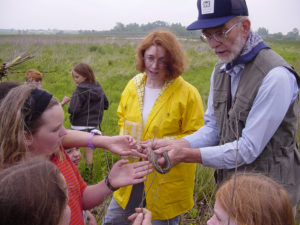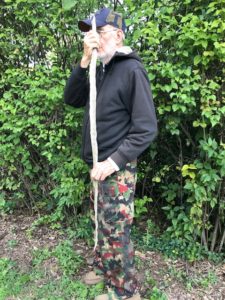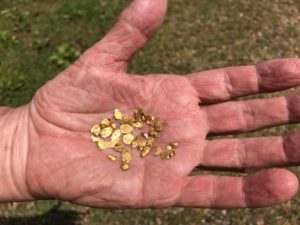Snakes and Us

Sharing a little snake around on a South Sycamore field trip.
A lot of people have an aversion to snakes. For some it is just a distaste, they would rather not get involved with them; while others are plainly terrified and don’t even want to look at them. And then there are some of us who just view them as another group of nature’s critters, and if we can apply appropriate caution, we don’t mind picking them up and handling them. I always thought I was in the latter group, without any negative instincts.
But when I built our combination fruit cellar and tornado shelter, it was a slow process and some mice moved in before I got the doors built. I didn’t realize that a substantial bull snake had followed them in. Weeks later I was installing shelving and stuck my head back between two shelves to set an awkward nail and found myself nose-to-nose with the snake, already coiled, and now rattling its tail against the shelf board. I leaped out of there so quick that I took the above shelf with me. Completely instinctive, no thought went into that decision. After my adrenalin calmed down, I tossed my big handkerchief over its head, grabbed it behind the head, let it coil itself around my forearm, and carried it outdoors. This species is a strong constrictor and s/he maintained a firm grip on my arm until I laid it down in the grass.

My fruit cellar snakeskin
Bull snakes seemed to be often found in pairs, so I searched carefully and instead of a second one I found the shed skin of the first.

Mojave gold
My behavior lends credence to the theory that people fear snakes because so many humans over our evolutionary time have been bitten and died, that the fear has evolved into an instinct not requiring a detailed analysis or evaluation, but simply requires immediate action. Evolution rewards those who respond instantly.
I once saw this in real time. When we lived in California in the early 1960s, my friend Lowell and I occasionally hiked into the Mojave Desert prospecting for gold and other interesting minerals.
One day Lowell was a few paces behind me on a narrow trail when I heard him yell. I turned around to see him doing a wild high-kicking dance and then realized that the snake attached to his foot was describing wide arcs and he was trying to shake it off. He succeeded and it sailed off into a bush and I ran over and found it to be a rattler. It transpired that the snake had struck his pantleg below his boot top and snagged its fangs in the fabric and couldn’t get loose. The blotch of venom was on his leather boot, so this was a serious strike, not a dry warning.
I asked Lowell if he had identified it as a rattler before starting his dance. He patiently explained to me, as though I was a dull child, that there really wasn’t time for that. We teased each other for the remainder of the weekend over the incident.

A Texas rattler in classic striking pose
So if someone gives you grief about your fear of snakes, just patiently mention that your ancestors have bequeathed to you a time-tested evolutionary response and you are happy to carry on the tradition.
There are also a few folks actually attracted to snakes, and go out of their way to share their lifestyle. One of our Geology graduate students, decades ago, not only studied fossil snakes but also kept a variety of live ones in glass aquariums in his office. The janitor refused to enter. So outside his door, said student rigged a wooden cigar box with a clothespin wound on a stout rubber band, so when someone began to open the lid, the clothespin would twirl and rattle in the box. According to departmental lore, the janitor ran screaming down the hall late one night. Said student also took a six-foot python on his honeymoon, carrying it into hotel rooms in a large suitcase.
So another successful evolutionary response may be to know your snakes so well that they don’t pose much danger to you.
So when you go out in nature, your response to snakes, spiders, and assorted bugs might be quite different than someone else’s, even your immediate family, because we have all inherited our unique mix of genetics and environmental experiences and can appreciate nature in different ways.


